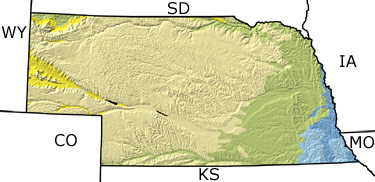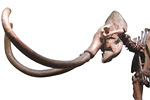

Nebraska, US |
|||||||||||||||||||||||||||||||||||||||||||||||||||||||||||||||
|
|||||||||||||||||||||||||||||||||||||||||||||||||||||||||||||||
Paleontology and geologyPrecambrian: Rocks of this time interval are found only in drill cores. They are metamorphic and igneous and do not contain fossils. Paleozoic: Although no surface outcrops of Early and Middle Paleozoic (Cambrian through Devonian) rocks occur in Nebraska, drill cores provide evidence that a warm, shallow sea periodically covered the state throughout this time interval. Few fossils occur in these samples, but careful studies of rocks of similar age in nearby states reveal that these tropical seas teemed with trilobites, corals, brachiopods, and other marine organisms. In the Late Paleozoic (Carboniferous), rivers flowing from the rising Appalachians to the east spread vast, swampy deltas westward across the state. By the end of the Paleozoic (Permian), most of Nebraska was above sea level, and amphibians, fish, and aquatic plants thrived in a variety of fresh and brackish water habitats. Mesozoic: There are no Early or Middle Mesozoic (Triassic and Jurassic) rocks known from Nebraska. The state stood above sea level, and erosion outpaced deposition. In the Late Mesozoic (Cretaceous), a shallow seaway spread northward across Nebraska. Dinosaurs roamed the coastal plains and early flowering plants grew abundantly. The warm marine waters of the seaway were home to giant sea turtles, plesiosaurs, fish, ammonites, and other animals. Cenozoic: By the Early Cenozoic (Tertiary), the Western Interior Seaway had withdrawn from the state. Sediments deposited in Nebraska during the Cenozoic represent a variety of terrestrial settings, such as rivers and lakes. Mammals, birds, and reptiles, many of which would be easily recognizable as relatives of living animals, roamed the landscape. Volcanic eruptions in the young Rockies periodically covered the state with blankets of ash. Glacial deposits from the Late Cenozoic (Pleistocene) preserve the remains of Ice Age elephants, horses, and other vertebrates. |
|||||||||||||||||||||||||||||||||||||||||||||||||||||||||||||||
Links to more on Nebraska paleontology |
|||||||||||||||||||||||||||||||||||||||||||||||||||||||||||||||
|
Organizations | Education and Exhibits | Resources OrganizationsEducation and Exhibits Resources
|
|||||||||||||||||||||||||||||||||||||||||||||||||||||||||||||||
|
site tour |
about the site |
site map |
site credits |
page credits |
help |
FAQs |
contact |
||

